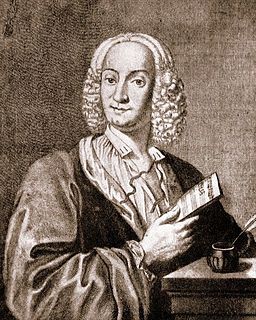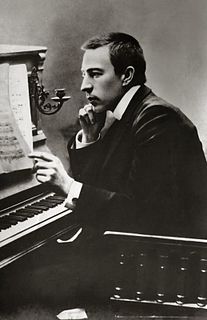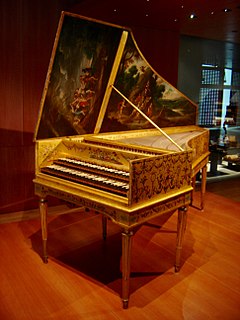
Georg Philipp Telemann was a German Baroque composer and multi-instrumentalist. Almost completely self-taught in music, he became a composer against his family's wishes. After studying in Magdeburg, Zellerfeld, and Hildesheim, Telemann entered the University of Leipzig to study law, but eventually settled on a career in music. He held important positions in Leipzig, Sorau, Eisenach, and Frankfurt before settling in Hamburg in 1721, where he became musical director of the five main churches. While Telemann's career prospered, his personal life was always troubled: his first wife died only a few months after their marriage, and his second wife had extramarital affairs and accumulated a large gambling debt before leaving Telemann.

Isaac Stern was an American violinist.

Oboes are a family of double reed woodwind instruments. The most common oboe plays in the treble or soprano range. Oboes are usually made of wood, but there are also oboes made of synthetic materials. A soprano oboe measures roughly 65 cm long, with metal keys, a conical bore and a flared bell. Sound is produced by blowing into the reed at a sufficient air pressure, causing it to vibrate with the air column. The distinctive tone is versatile and has been described as "bright". When oboe is used alone, it is generally taken to mean the treble instrument rather than other instruments of the family, such as the bass oboe, the cor anglais, or oboe d'amore

In music, a cadenza is, generically, an improvised or written-out ornamental passage played or sung by a soloist or soloists, usually in a "free" rhythmic style, and often allowing virtuosic display. During this time the accompaniment will rest, or sustain a note or chord. Thus an improvised cadenza is indicated in written notation by a fermata in all parts. A cadenza usually will occur over the final or penultimate note in a piece, or over the final or penultimate note in an important subsection of a piece. It can also be found before a final coda or ritornello.

A concerto is a musical composition generally composed of three movements, in which, usually, one solo instrument is accompanied by an orchestra or concert band. It is accepted that its characteristics and definition have changed over time. In the 17th century, sacred works for voices and orchestra were typically called concertos, as reflected by J. S. Bach's usage of the title "concerto" for many of the works that we know as cantatas.

The Four Seasons is a group of four concerti grossi by Italian composer Antonio Vivaldi, each of which gives musical expression to a season of the year. They were written around 1721 and were published in 1725 in Amsterdam, together with eight additional concerti grossi, as Il cimento dell'armonia e dell'inventione.

The Brandenburg Concertos by Johann Sebastian Bach are a collection of six instrumental works presented by Bach to Christian Ludwig, Margrave of Brandenburg-Schwedt, in 1721. They are widely regarded as some of the best orchestral compositions of the Baroque era.

A piano concerto is a type of concerto, a solo composition in the Classical music genre which is composed for a piano player, which is typically accompanied by an orchestra or other large ensemble. Piano concertos are typically virtuoso showpieces which require an advanced level of technique on the instrument, including melodic lines interspersed with rapid scales, arpeggios, chords, complex contrapuntal parts and other challenging material. When piano concertos are performed by a professional concert pianist, a large grand piano is almost always used, as the grand piano has a fuller tone and more projection than an upright piano. Piano concertos are typically written out in music notation, including sheet music for the pianist, orchestra parts for the orchestra members, and a full score for the conductor, who leads the orchestra in the accompaniment of the soloist.

A violin concerto is a concerto for solo violin and instrumental ensemble. Such works have been written since the Baroque period, when the solo concerto form was first developed, up through the present day. Many major composers have contributed to the violin concerto repertoire, with the best known works including those by Bach, Bartók, Beethoven, Brahms, Bruch, Mendelssohn, Mozart, Paganini, Prokofiev, Shostakovich, Sibelius, Tchaikovsky, Dvorak and Vivaldi.

The Piano Concerto No. 5 in E♭ major, Op. 73, by Ludwig van Beethoven, popularly known as the Emperor Concerto, was his last completed piano concerto. It was written between 1809 and 1811 in Vienna, and was dedicated to Archduke Rudolf, Beethoven's patron and pupil. The first performance took place on 13 January 1811 at the Palace of Prince Joseph Lobkowitz in Vienna, with Archduke Rudolf as the soloist, followed by a public concert on 28 November 1811 at the Gewandhaus in Leipzig under conductor Johann Philipp Christian Schulz, the soloist being Friedrich Schneider. On 12 February 1812, Carl Czerny, another student of Beethoven's, gave the Vienna debut of this work.
A clarinet concerto is a concerto for clarinet; that is, a musical composition for solo clarinet together with a large ensemble. Albert Rice has identified a work by Giuseppe Antonio Paganelli as possibly the earliest known concerto for solo clarinet; its score appears to be titled "Concerto per Clareto" and may date from 1733. It may, however, be intended for soprano chalumeau. There are earlier concerti grossi with concertino clarinet parts including two by Johann Valentin Rathgeber, published in 1728.

Felix Mendelssohn's Violin Concerto in E minor, Op. 64, is his last large orchestral work. It forms an important part of the violin repertoire and is one of the most popular and most frequently performed violin concertos in history. A typical performance lasts just under half an hour.

The Piano Concerto No. 2 in C minor, Op. 18, is a concerto for piano and orchestra composed by Sergei Rachmaninoff between the autumn of 1900 and April 1901. The second and third movements were first performed with the composer as soloist on 2 December 1900. The complete work was premiered, again with the composer as soloist, on 9 November 1901, with his cousin Alexander Siloti conducting.

The Honda Concerto is an automobile co-developed by Honda and the Austin Rover Group. Based on the fourth generation Honda Civic it was introduced in Japan on 15 June 1988,, while the British-built European-market version was introduced in October 1989. The production lasted until October 1992 in Japan and 1994 in England. Named for the musical composition, and primarily designed for European tastes, the Concerto was the successor to the second generation Honda Ballade, and the Honda Integra which was discontinued for the European Market owing to its unpopularity. All Japanese versions were exclusive to Japanese Honda dealerships called Honda Clio.

D major is a major scale based on D, consisting of the pitches D, E, F♯, G, A, B, and C♯. Its key signature consists of two sharps. Its relative minor is B minor and its parallel minor is D minor.

In music theory, B-flat major is a major scale based on B♭, with pitches B♭, C, D, E♭, F, G, and A. Its key signature has two flats. Its relative minor is G minor and its parallel minor is B-flat minor.

E-flat major is a major scale based on E♭, with the pitches E♭, F, G, A♭, B♭, C, and D. Its key signature has three flats: B, E, and A. Its relative minor is C minor, while its parallel minor is E♭ minor.

A minor is a minor scale based on A, with the pitches A, B, C, D, E, F, and G. Its key signature has no flats and no sharps. Its relative major is C major and its parallel major is A major.

Wolfgang Amadeus Mozart wrote 23 original concertos for piano and orchestra. These works, many of which Mozart composed for himself to play in the Vienna concert series of 1784–86, held special importance for him.
The Horn Concertos by Wolfgang Amadeus Mozart were written for his friend Joseph Leutgeb whom he had known since childhood. Leutgeb was a skilled player, as the works are very difficult to perform on the natural horn of the period, requiring lip trills, much hand-stopping, and rapid tonguing.




















